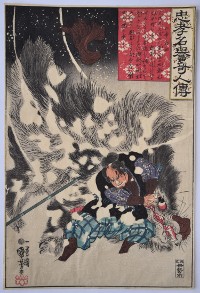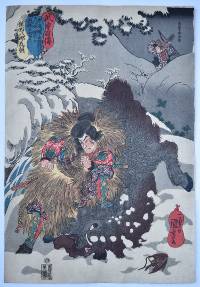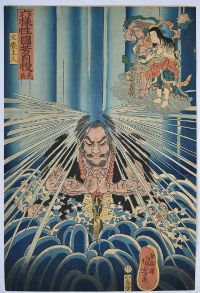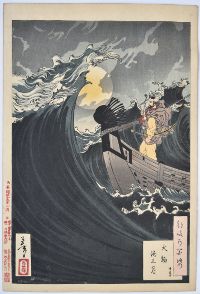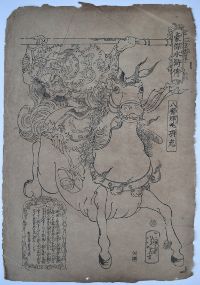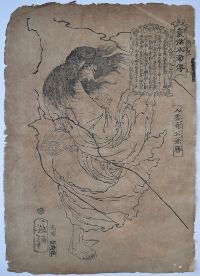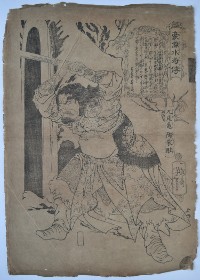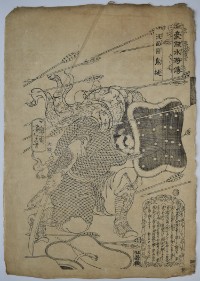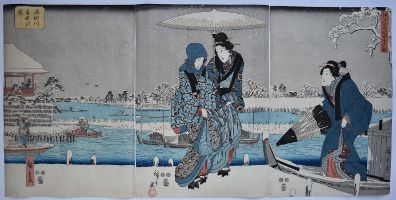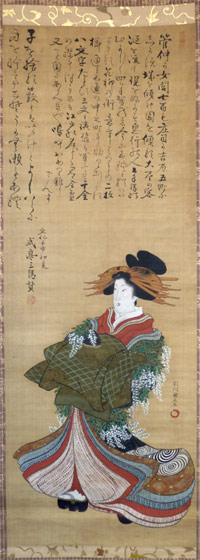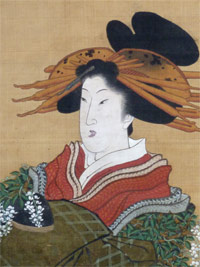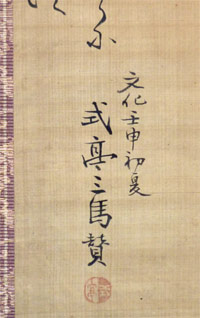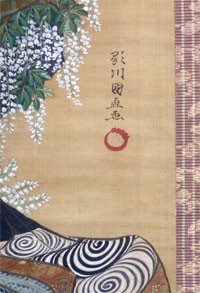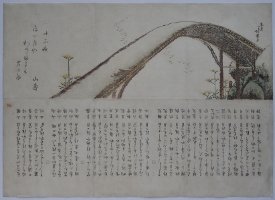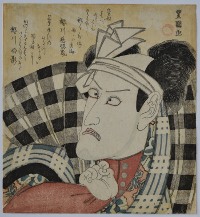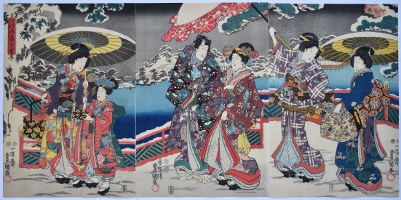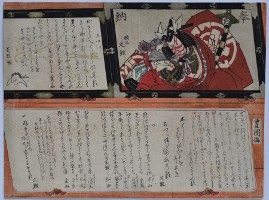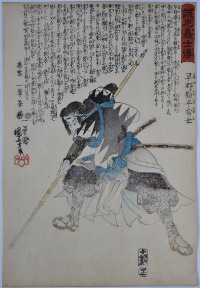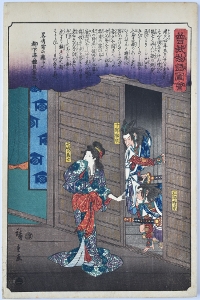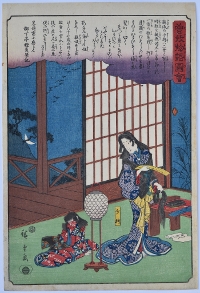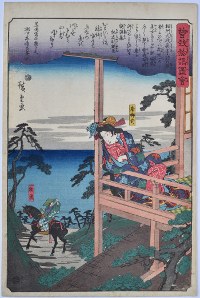/category/archive/page/17/
Utagawa KUNIYOSHI (1797-1861)
Click here to view image full size.
The samurai Yamamoto Kansuke from the set Chuko meiyo kijin den, “Stories of Remarkable Persons of Loyalty and High Reputation.” Published by Iseya Ichiemon (this design) or Enshuya Matabei 1845. Robinson S35.16. One of Takeda Shingen’s most trusted 24 Generals. He is shown fighting a wild boar in deep snow. A fine design.
Very fine impression and colour. Very slight crinkling and trimmed close, otherwise fine condition. Signed Ichiyusai Kuniyoshi ga.
Status: Sold
Utagawa KUNIYOSHI (1797-1861)
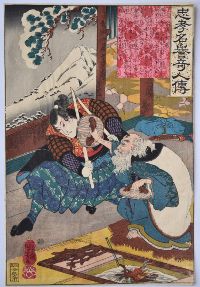
Click here to view image full size.
Miyamoto Musashi fencing with Tsukahara Bokuden from the set Chuko meiyo kijin den, “Stories of Remarkable Persons of Loyalty and High Reputation.” Published by Iseya Ichiemon (this design) or Enshuya Matabei 1845. Robinson S35.8. Tsukahara Bokuden was a famous swordsman (1489-1571). He is shown here parrying Musashi’s wooden swords with pot lids. Actually, Bokuden died 13 years before Musashi was born, so this is anecdotal.
Superb impression and colour. Very slight crinkling and trimmed close, otherwise fine condition. Signed Ichiyusai Kuniyoshi ga.
Status: Sold
Utagawa KUNIYOSHI (1797-1861)
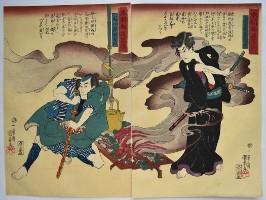
Click here to view image full size.
A complete diptych showing Inuyama Dosetsu Tadatomo with smoke curling around him and his hand on one of his swords facing Inugawa Sosuke Yoshito on one knee grasping his sword beside a wood fire from which the billowing smoke is emanating. Two of the heroes from Kyokutei Bakin’s famous book, Nanso Satomi hakkenden, “The Chronicles of the Eight Dog Heroes of the Satomi Clan of Nanso.” From a set of prints Kendo ryaku den “Abridged Stories of Our Country’s Swordsmamship.” Published by Kadzusa-ya Iwazo, c. 1845-6. The complete diptych is rare. Robinson S37.9.7.
Very fine impression, colour and condition. Signed Ichiyusai Kuniyoshi ga.
Status: Sold
Utagawa KUNIYOSHI (1797-1861)
Click here to view image full size.
Chinzei Hachiro Tametomo battling a large wild boar in the snowy mountains of Mashiki in the province of Higo, watched from above by Takama Harutsugu. A rare print from a rare unfinished (?) series Buyu hyaku den, “A Hundred Stories of Military Valour.” Published by Fujioka-ya Hikotaro, c. 1836.
Fine impression and colour. Slight fold, otherwise fine condition. Signed Ichiyusai Kuniyoshi ga.
Status: Sold
Utagawa KUNIYOSHI (1797-1861)
Click here to view image full size.
The priest Mongaku Shonin doing thirty-seven days’penance under the freezing Nachi waterfall near Kyoto. He is helped by Fudo Myo-o’s two attendants Seitaki and Kongara seen here top right. This act of self-mortification is because he accidentally killed his beloved cousin Kesa. Published by Uoya Eikichi, 1860. A fine design.
Very good impression, colour and condition. Signed Cho-o-ro Kuniyoshi ga.
Status: Sold
Utagawa KUNINAO (1793-1854)
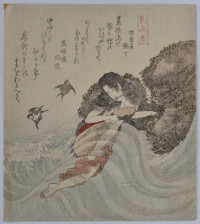
Click here to view image full size.
A surimono with series title Bijin awase, “Beautiful Women.” Shows a scantily clad diver emerging from waves holding an abalone shell and clinging to a rock. There are obvious erotic overtones to this wonderful surimono: Awabi divers were objects of great voyeuristic curiosity to the general public and feature in many aspects of Japanese art. Poems by Chinchoya Chincho and Jingoro Takumi. Provenance: Ex collection Louis Gonse, 1846-1921, who was a great collector of Japanese art and published L’Art Japonaise in 1883. Seal au verso. Very Rare: Other impressions are in the Chester Beatty Library, Dublin. See The Art of Surimono, Roger Keyes, 1985, no. 236, p. 267; MFA, Boston, RES.46.27; and illustrated in McKee, Colored in the Year’s New Light: Japanese Surimono From The Becker Collection, Cornell University, 2008, no. 112.
Fine impression and colour with silver printing to the waves. Evidence of mounting around edge au verso, otherwise fine condition. Artist’s seal Kuninao.
Status: Sold
Tsukioka YOSHITOSHI (1839-1892)
Click here to view image full size.
The best design from the set Tsuki hyakushi, the “Hundred Phases of the Moon.” The set published between 1885 and 1892 (this being 1886) by Akiyama Buemon. Shows Benkei on the prow of the ship in which Yoshitsune was forced to flee to northern Japan after being attacked by his half-brother Minamoto no Yoritomo. Sailing along the Inland Sea off the coast of Harima Province not far from Kyoto, the ship was struck by a storm in Daimotsu Bay caused by the vengeful ghosts of the Taira warriors Yoshitsune and his men had slain. Benkei pacified the spirits by holding up his string of prayer beads.
Fine impression and colour. Light album backing, otherwise very good condition. Signed Yoshitoshi.
Status: Sold
Tsukioka YOSHITOSHI (1839-1892)
Click here to view image full size.
A unique key-block proof of Happinata Kojo (Chin: Xiang Chong) riding into battle on his horse. This appears to be a proof for an unpublished print for the set Goketsu Suikoden, “Heroes of the Suikoden” published by Ohashi in 1868. Keyes lists just seven designs in this set. Aratame and date seal for 7/1868 and engraver’s seal Hori Wakasa. No publisher’s seal. The kento marks just visible. Browned and creased but commensurate with having survived. Sold “as is.” Signed Ikkaisai Yoshitoshi hitsu.
Status: Sold
Tsukioka YOSHITOSHI (1839-1892)
Click here to view image full size.
A key-block proof of Juunryu Kosonsho (Chin: Kun-sun Sheng) praying with lightning flashing around him. From the set Goketsu Suikoden, “Heroes of the Suikoden” published by Ohashi in 1868. Keyes lists just seven designs in this set. Aratame and date seal for 7/1868 and engraver’s seal Hori Wakasa. Publisher’s seal Ohashi (Daikyodo). One kento mark visible. Browned and creased but commensurate with having survived. Sold “as is.” Signed Ikkaisai Yoshitoshi hitsu.
Status: Sold
Tsukioka YOSHITOSHI (1839-1892)
Click here to view image full size.
A unique key-block proof of Kyubiki Toso-o (Chin: Tao Tsung-Wang) brandishing a sword. This appears to be a proof for an unpublished print for the set Goketsu Suikoden, “Heroes of the Suikoden” published by Ohashi in 1868. Keyes lists just seven designs in this set. Aratame and date seal for 7/1868. The outline for the engraver’s seal printed but the name not inserted. No publisher’s seal. The kento marks evident. Browned and creased but commensurate with having survived. Sold “as is.” Signed Ikkaisai Yoshitoshi hitsu.
Status: Sold
Tsukioka YOSHITOSHI (1839-1892)
Click here to view image full size.
A key-block proof of Botsumenmoku Shotei (Chin: Chiao Ting). From the set Goketsu Suikoden, “Heroes of the Suikoden” published by Ohashi in 1868. Keyes lists just seven designs in this set. Aratame and date seal for 8/1868 and engraver’s seal Hori Wakasa. Publisher’s seal Ohashi (Daikyodo). Kento marks visible. Some creasing but commensurate with having survived. Sold “as is.” Signed Ikkaisai Yoshitoshi hitsu.
Status: Sold
Ichiryusai HIROSHIGE (1797-1858)
Click here to view image full size.
Winter from a set of four triptychs: Edo meisho shiki-no nagame Sumidagawa setchu no zu, “Views of the Four Seasons at Famous Places in Edo, Snow on the Sumida River.” A famous print. Published by Marujin, 1848-9. Shows beauties and ferry boats on the river, a tea-house on the left.
Fine impression. Slight fading, otherwise very good colour. Very good condition. The block for the centre panel had vertical cracks in it from the very start. These striations are evident to the left and right of the figures and are on all impressions, becoming more evident on later pulls. Signed Hiroshige ga.
Status: Sold
Utagawa HIROSHIGE (1797-1858)
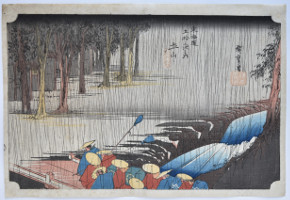
Click here to view image full size.
Tsuchiyama, haru no ame, “Tsuchiyama, Spring Rain.” Number 49 from the famous Tokaido gojusan tsugi no uchi, “The Fifty-three Stations of the Tokaido.” Published by Hoeido, c. 1833-4. Hiroshige travelled the length of the Tokaido as part of an official delegation in 1832 making sketches along the way. On his return he started work on the set eventually producing 55 prints. The first of the designs were published jointly by Hoeido and Senkakudo, but then Hoeido took over the production. Shows a daimyo’s cortege crossing the Tamura River. Tsuchiyama flourished because of its location at the entrance to the Suzuka Pass. However, in Meiji times, the town was bypassed by the railway because of the steep gradients here. This is the rare first edition.
Fine impression. Slight fading of seals, slight centre fold and minimal soil to left edge, otherwise very good condition. Signed Hiroshige ga.
Status: Sold
Utagawa HIROSHIGE (1797-1858)
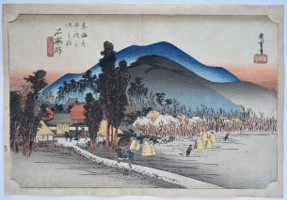
Click here to view image full size.
Ishiyakushi, number 44 from the Tokaido showing figures entering the village with others working in the fields. Ishiyakushi-ji Temple was seen on entering the village. From the famous Tokaido gojusan tsugi no uchi, “The Fifty-three Stations of the Tokaido.” Published by Hoeido, c. 1833-4. Hiroshige travelled the length of the Tokaido as part of an official delegation in 1832 making sketches along the way. On his return he started work on the set eventually producing 55 prints. The first of the designs were published jointly by Hoeido and Senkakudo, but then Hoeido took over the production. This is the rare first edition.
Fine impression. Slight fading of seals, slight centre fold and minimal soil to left edge, otherwise very good condition. Signed Hiroshige ga.
Status: Sold
Ichiryusai HIROSHIGE (1797-1858)
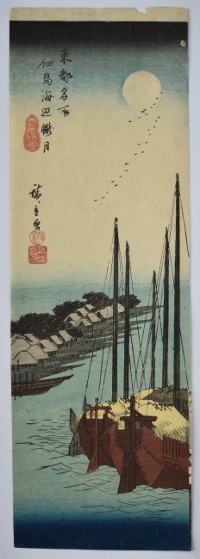
Click here to view image full size.
Spring moon at the shore of Tsukudajima. One of a set of chu-tanzaku prints published by Shogendo, c.1837. Tsukudajima was one of two islands at the mouth of the Sumida River. Originally a sandbar, it was reclaimed with earth and rocks and given its name by the first Tokugawa Shogun, Ieyasu, who invited thirty-three fishermen to live there in 1613 in order to provide fish for the rapidly expanding city of Edo. The fishermen came from Tsukudama near Osaka. And it was they who became the proprietors of what would become the Tsukiji fish market. It must have been popular during the late Edo period as a place to visit and view the boats from teahouses on the shore because there are many prints depicting the area, especially under a full moon.
Fine impression, colour and condition. Signed Hiroshige ga.
Status: Sold
Utagawa HIROSHIGE (1797-1858)
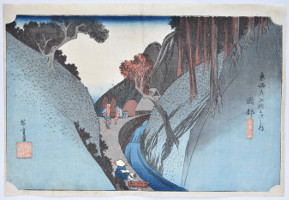
Click here to view image full size.
Okabe, Utsu no yama, “Okabe, Utsu Mountain.” Number 21 from the famous Tokaido gojusan tsugi no uchi, “The Fifty-three Stations of the Tokaido.” Published by Hoeido, c. 1833-4. Hiroshige travelled the length of the Tokaido as part of an official delegation in 1832 making sketches along the way. On his return he started work on the set eventually producing 55 prints. The first of the designs were published jointly by Hoeido and Senkakudo, but then Hoeido took over the production. Utsunoya Pass is just before Okabe. The pass is the scene of a Kabuki play by Mokuami Kawatake (1816-1893) where Jubei Itamiya kills and robs the blind Bun’ya. This is the rare first edition.
Fine impression. Slight fading of seals, slight centre fold and minimal soil to left edge, otherwise very good condition. Signed Hiroshige ga.
Status: Sold
Utagawa HIROSHIGE (1797-1858)
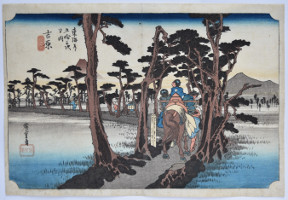
Click here to view image full size.
Yoshiwara, hidari Fuji, “Yoshiwara, Mount Fuji on the left.” Number 14 from the famous Tokaido gojusan tsugi no uchi, “The Fifty-three Stations of the Tokaido.” Published by Hoeido, c. 1833-4. Hiroshige travelled the length of the Tokaido as part of an official delegation in 1832 making sketches along the way. On his return he started work on the set eventually producing 55 prints. The first of the designs were published jointly by Hoeido and Senkakudo, but then Hoeido took over the production. After being destroyed by a tidal wave in 1680 Yoshiwara was rebuilt further inland from the sea. This is the rare first edition.
Fine impression. Slight fading of seals, slight centre fold and minimal soil to left edge, otherwise very good condition. Signed Hiroshige ga.
Status: Sold
Utagawa HIROSHIGE (1797-1858)
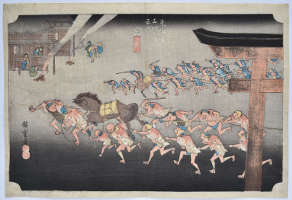
Click here to view image full size.
Miya, Atsuta shinji, “Miya, Festival of the Atsuta Shrine.” Number 41 from the famous Tokaido gojusan tsugi no uchi, “The Fifty-three Stations of the Tokaido.” Published by Hoeido, c. 1833-4. Hiroshige travelled the length of the Tokaido as part of an official delegation in 1832 making sketches along the way. On his return he started work on the set eventually producing 55 prints. The first of the designs were published jointly by Hoeido and Senkakudo, but then Hoeido took over the production. Miya was the largest station on the Tokaido. There were many inns catering for the pilgrims going to Ise and daimyo travelling to Edo. Shows the horse-driving festival held at the Shinto Atsuta Shrine, the Hama Gateway to the right. This is the rare first edition.
Fine impression. Slight fading of seals, slight centre fold and minimal soil to left edge, otherwise very good condition. Signed Hiroshige ga.
Status: Sold
Utagawa HIROSHIGE (1797-1858)
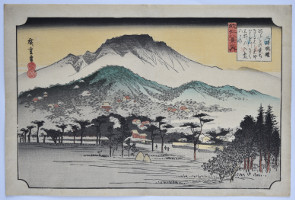
Click here to view image full size.
Mii no bansho, “Evening Bell at Miidera Temple” from an early set Omi hakkei no uchi, “Eight Views in Omi Province.” Shows the temple hidden amongst hills on the southern side of Lake Biwa. Miidera is the common name for the Onjoji, a temple of the Tendai sect, founded in 858. Published by Hoeido and Eikyudo in c. 1834-5. The “Eight Views” theme was derived (as so much else in Japanese art) from China and based on the Eight Views of Xiaoxiang paintings of the 11th century. The subject was transposed to Omi and then taken up by such artists as Harunobu , and later Hiroshige. It was also often playfully alluded to in sets of eight prints in mitate-e style.
Fine early impression and colour. Imperceptible centre fold, otherwise fine condition. Signed Hiroshige ga.
Status: Sold
Utagawa HIROSHIGE II (1829-1869)
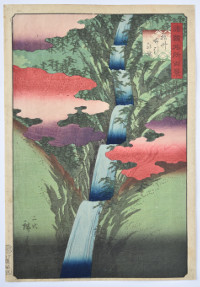
Click here to view image full size.
Sesshu Nunobiki no taki, “The Nunobiki Waterfall in Settsu Province,” from a set Shokoku meisho hyakkei, “One Hundred Famous Views in the Various Provinces.” The set published by Uoya Eikichi between 1859 and 1861 (this being 1859). He was the pupil of Hiroshige, given the name Shigenobu. After Hiroshige’s death he married his adopted daughter and became Hiroshige II. The couple were divorced in 1865. She went on to marry another pupil of her father’s – Shigemasa, who became Hiroshige III.
Superb impression and colour with extensive mica and woodgrain. Fine condition. Signed “The second” Hiroshige ga.
Status: Sold
Katsushika HOKUSAI (1760-1849)
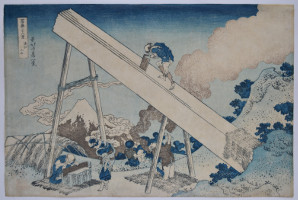
Click here to view image full size.
Totomi sanchu, “In the Totomi Mountains” from Hokusai’s most famous set Fugaku sanju-rokkei, “Thirty-six Views of Fuji.” The set published by Nishimuraya Yohachi c. 1830-33. Originally planned as a set of 36 prints, ten more designs were added. These are called the Ura-Fuji, “Fuji from the Other Side.” These designs have a black outline, while early impressions of the first 36 are printed with a blue outline changing to black on later editions. Shows lumbermen cutting a huge log while another, lower left, sharpens a saw watched by a woman with a child strapped to her back. This set was a considerable undertaking for the publisher, especially as the relatively new pigment berurin burau, “Berlin blue” was being used which was expensive.
Very good impression, colour and condition. Very full size. Signed Saki no Hokusai Iitsu hitsu.
Status: Sold
Utagawa KUNIYOSHI (1797-1861)
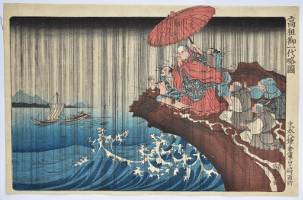
Click here to view image full size.
Nichiren praying for rain from the set Koso goichidai ryakuza, “Illustrated Abridged Biography of the Founder.” The set published by Iseya Rihei, c. 1835. The event is supposed to have taken place at the Reizan Promontory, Kamakura in 1271. Bunei hachi Kamakura Reizangasake uki. Nichiren was the founder of the Buddhist Nichiren sect of which Kuniyoshi was a follower. This is the very rare first edition without the break in the black border on the left near the small boat. Another first edition impression is in the Baur Collection, Geneva. See Matthi Forrer, 1994, G366. Most impressions show the break. For example: Kuniyoshi, Juzo Suzuki, 1992, no. 179. There are also variant later impressions with differences in the gradation of the sea and the promontory.
Very fine impression. Fine colour. Imperceptible centre fold and trimming at top, otherwise very good condition. Signed Ichiyusai Kuniyoshi ga.
Status: Sold
Ichieisai YOSHITSUYA (1822-1866)
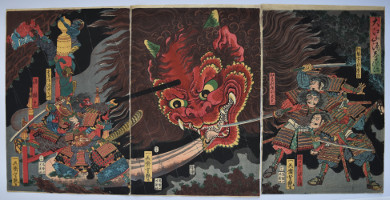
Click here to view image full size.
Oeyama Shuten doji. Shows Minamoto no Raiko and his four retainers, from left to right: Sakata no Kintoki, Usui no Sadamitsu, Watanabe no Tsuna and Urabe no Suyetake on Oyeyama, “Devil’s Mountain.” In the year 995 the Emperor commanded Raiko to kill the beast who had been kidnapping and eating young maidens around Kyoto. They accomplished this by dressing as priests and getting Shuten-doji incapacitated with alcohol. Raiko has just decapitated the giant head of the demon which then descends on his helmet which saves him. Published 1855 by Kiya Sojiro . A fine design.
Fine impression and colour. Expert edge repair at top right edge of first sheet, otherwise very good condition. Signed Ichieisai Yoshitsuya ga.
Status: Sold
Tsukioka YOSHITOSHI (1839-1892)
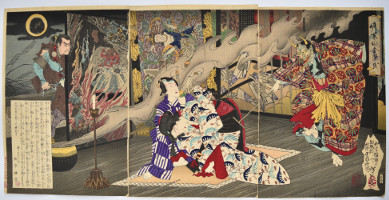
Click here to view image full size.
Nise Murasaki inaka Genji, “An Imposter Murasaki and a Rustic Genji.” A triptych based on an involved story written by Ryutei Tanehiko in 1829 and based on the classic 11th century Tale of Genji. Shows Prince Genji with his lover Tasogare at an old temple. A demon appears pretending to be Genji’s wife Futaba, but in reality is Tasogare’s mother, Shinonome. Genji, discovering her true identity, reveals that his affair with her daughter is only in order to regain the family sword. Tasogare and her mother commit suicide due to the great shame. Published by Akiyama Buemon in 1884.
Fine impression, colour and condition. Signed Yoshitoshi sha.
Status: Sold
Utagawa KUNIYOSHI (1797-1861)
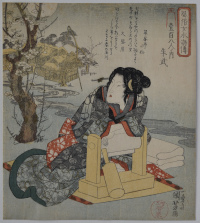
Click here to view image full size.
A surimono from a series: Fuzoku onna Suikoden hyakuhachiban no uchi, “Modern Women as the One Hundred and Eight Heroes of the Suikoden.” Shows a beauty leaning on a fulling block beside a stream. She gazes at a flowering cherry tree with a village in the distance beneath a full moon. Each design is based on one of the characters from the Suikoden; in this case Shinkigunshi Shubu (Zhu Wu), the “Resourceful Strategist.” The series was inspired by a new translation of the 12th century Chinese novel Shui huchuan, “All Men are Brothers” which relates the deeds of a group of outlaws. Commissioned by the Hisakatayaren Club for the New Dragon Year 1832. Surimono were usually issued by these poetry clubs or for specific occasions, although individuals also commissioned them. They could employ every artifice available to the printers and engravers: metal powders, mica, blind-printing and burnishing, and were printed on the best, thick hosho. They were not issued in large numbers as conventional Ukiyo-e and are usually of a smaller format. Presumably ambitiously planned as 108 prints but never completed. Rare.
Very fine impression and colour with silver and gold. Slightly trimmed top and bottom, otherwise very god condition. Signed Ichiyusai Kuniyoshi ga with the red seal of the printer Suriko Shinzo (which is removed on some impressions).
Status: Sold
Ryuryukyo SHINSAI (1764[?]-1823)
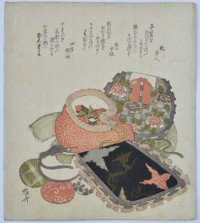
Click here to view image full size.
An early pupil of Hokusai who is best known for his fine surimono, but also produced a series of semi-western style landscapes and some paintings. A still life showing a group of pouches, one revealing a lacquered surface with a stylised dragon. Dragon year was 1808 and 1820. Extremely rare. Ex Beres collection, seal au verso.
Fine impression with extensive silver and burnishing. Fine colour. Very good condition. Signed Shinsai.
Status: Sold
Utagawa KUNINAO (1793-1854)
Click here to view image full size.
An original painting showing a sumptuously attired parading courtesan. Kuninao was a pupil of Toyokuni, then a follower of Hokusai. Above is a lengthy inscription on the Yoshiwara by Shikitei Sanba ( 1776-1822 ). Together with Santo Kyoden, a professional writer of gesaku fiction. Famous for one of the best known works of the late Edo period; Ukiyoburo or “Bathhouse of the Floating World” ( 1809 ). Full colour on silk, 33.25 x 12.25 in; 84.5 x 31 cms. Slight browning, otherwise good condition. Old mount in good condition. Painting signed Utagawa Kuninao with Utagawa seal. Inscription signed and sealed Shikitei Sanba with date Bunka 9 ( 1812 ).
Status: Sold
Totoya HOKKEI (1780-1850)
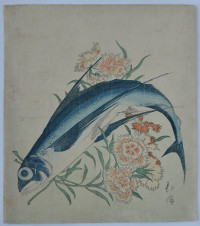
Click here to view image full size.
A surimono showing an unidentified fish – possibly a flying fish and carnations. An apparently unrecorded surimono. A pupil of Hokusai, Hokkei’s oeuvre was almost entirely in this genre, apart from illustrating ehon.
Very good impression and colour. Slight crease, otherwise very good condition. Signed Hokkei.
Status: Sold
Totoya HOKKEI (1780-1850)
Click here to view image full size.
An uncut large surimono with the poems attached showing a rustic bridge in a country setting. Geese flying above. Published c 1810s. Provenance: Ex Samuel Tuke collection, seal centre left. Tuke was a member of the Japan Society of London and many of his prints went to the British Museum, while others were sold at Sothebys in 1911. Rare.
Very good impression, colour and condition. Signed Totoya Hokkei ga.
Status: Sold
Chokotei TOSHIMASA (Active c 1810s)
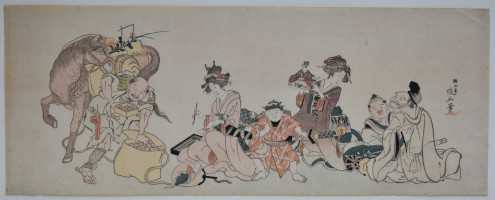
Click here to view image full size.
A long surimono for a Horse year (probably 1810). Shows the Five Festivals, Gosekku no uchi, which are: Matsu-no-uchi, New Year; Hinamatsuri, Girls’ Day, or Doll Festival; Tango-no-sekku, Boys’ Day; Tanabata, Star Festival; Choyo-no-sekku, Chrysanthemum Festival.
Very good impression, colour and condition. Signed Chokotei Toshimasa hitsu.
Status: Sold
Utagawa TOYOKUNI II (1777-1835)
Click here to view image full size.
A surimono showing a bust portrait of the actor Ichikawa Danjuro VII as Kanawa no Goro, a retainer of Kamatari no Fujiwara, disguised as the fisherman Fukashichi from the Mikasayama Goten scene in Act 4 of Imoseyama onna teikino. Three poems by Shoshokyo Otokado, Sakuragawa Jihinari, and Sakuragawa Omokage. Issued c mid-1820s. Provenance: originally purchased from me in 1977 (see my catalogue 20, 1977, no. 38). Unidentified collector’s seal au verso. Rare.
Very good impression, colour and condition. Signed Toyokuni ga.
Status: Sold
Utagawa YOSHITSUYA (1822-1866)
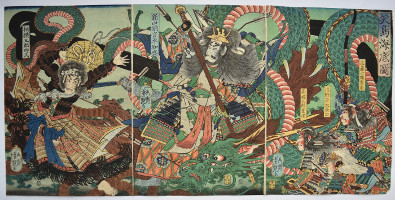
Click here to view image full size.
A triptych showing the defeated generals Shin Chunagon Taira no Tomomori and Sagami Goro Tokiuji of the Taira Clan, having committed suicide, at the bottom of the sea near Yashima Dan-no-Ura in 1185. The Taira were defeated by the Minamoto led by Minamoto no Yoshitsune. Tomomori facilitated his drowning by tying a giant anchor to himself. A large dragon coils around them representing the royal household. Yoshitsuya designed another triptych version of this scene but this interpretation is by far the rarer. Published by Kagaya Kichibei, 1861.
Very good impression, colour and condition. Signed Ichieisai Yoshitsuya ga.
Status: Sold
Utagawa YOSHIKAZU (Active c. 1850-1870)
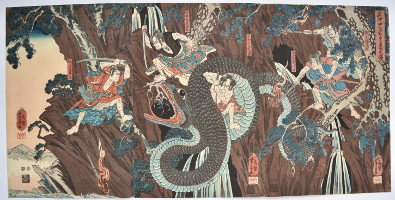
Click here to view image full size.
A triptych showing The Four Heavenly Kings, loyal retainers of Kiso Yoshinaka (1154-1184) killing a giant snake. Yoshinaka no Shitenno Kiso okuyama ni kore o taiji su. Yoshinaka was a general of the Minamoto Clan. Published by Amatsu, 1851-2.
Fine impression. Very good colour. Sheets attached, otherwise very good condition. Signed Isshunsai Yoshikazu ga.
Status: Sold
Utagawa KUNISADA (1786-1864)
Click here to view image full size.
Winter from a set of the four seasons showing Prince Genji and attendants in the snow-covered grounds of a palace. Published by Enshuya Hikobei, c 1849-50.
Fine impression and colour. Slight trimming, otherwise fine condition. Signed Ichiyusai Toyokuni ga.
Status: Sold
Ichiyusai KUNIYOSHI (1797-1861)
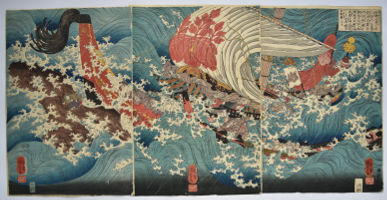
Click here to view image full size.
A triptych Buzen no kuni oki manaita ga se, “The Chopping Block Shoals off the Coast of Buzen Province.” Shows the pilot and nobleman Yoshibei leaping to a rock and sacrificing himself to save his ship which was travelling to the capital from Kyushu when it was caught in a violent storm. Published c. 1850 by Mikawaya Tetsugoro. A wonderful and rare triptych.
Fine impression, colour and condition. Signed Ichiyusai Kuniyoshi ga.
Status: Sold
Utagawa TOYOKUNI I (1769-1825)
Click here to view image full size.
A surimono in the form of an ema (literally “picture-horse”) which were votive tablets left at Shinto shrines. The upper right plaque shows an actor in Shibaraku role with characters reading ganshu (temple petitioner) Bunri. Below, ten poems by poets from Edo, Kyoto and Osaka. The poem below the actor is signed Shikan which was the stage name and literary name of Nakamura Shikan I (Utaemon III, 1778-1838) who is most likely the actor portrayed. The text on the top left panel begins with San kudari indicating the 3rd came back, suggesting a return by Utaemon to Edo from acting in Kyoto or Osaka. Issued c 1810s. Very rare.
Very good impression, colour and condition. Signed Toyokuni ga.
Status: Sold
Utagawa KUNIYOSHI (1797-1861)
Click here to view image full size.
The ghost of Hayano Kampei Tsuneyo lunging forward with his spear. From the set Seichu gishi den, “Biographies of Loyal and Righteous Samurai” in other words, The forty-Seven Ronin. Published by Ebiya Rinnosuke, c 1847-8. Robinson S53.47.
Very good impression, colour and condition. This design is beautifully printed, the blue and sumi graded off to indicate the ghostly status of Tsuneyo. Signed Ichiyusai Kuniyoshi ga.
Status: Sold
Ichiryusai HIROSHIGE (1797-1858)
Click here to view image full size.
Oiso no Maihime telling the Soga brothers the whereabouts of Suketsune. From a set Soga monogatari zue, “The Revenge of the Soga Brothers.” A set of 30 prints published by Ibaya Senzaburo, 1848. This famous story has many versions but basically it tells how Kawazu Sukeyasu was murdered by his cousin Kudo Suketsune. Sukeyasu left two sons and his widow remarried a man named Soga. He adopted the two children and they waited patiently for an opportunity to kill Suketsune which came when he was hunting near Mt Fuji. They killed him but were themselves slain in the ensuing battle. This is the first edition, it was republished in 1858 by Yamaguchiya Tobei.
Fine impression and colour. Light album backing, otherwise fine condition. Signed Hiroshige ga.
Status: Sold
Ichiryusai HIROSHIGE (1797-1858)
Click here to view image full size.
Kewaizaka no Shosho cuts her hair to become a nun. From a set Soga monogatari zue, “The Revenge of the Soga Brothers.” A set of 30 prints published by Ibaya Senzaburo, 1848. This famous story has many versions but basically it tells how Kawazu Sukeyasu was murdered by his cousin Kudo Suketsune. Sukeyasu left two sons and his widow remarried a man named Soga. He adopted the two children and they waited patiently for an opportunity to kill Suketsune which came when he was hunting near Mt Fuji. They killed him but were themselves slain in the ensuing battle. This is the first edition, it was republished in 1858 by Yamaguchiya Tobei.
Fine impression and colour. Light album backing, otherwise fine condition. Signed Hiroshige ga.
Status: Sold
Ichiryusai HIROSHIGE (1797-1858)
Click here to view image full size.
Soga no Juro on a horse lower left bids farewell to his lover, Tora Gozen. From a set Soga monogatari zue, “The Revenge of the Soga Brothers.” A set of 30 prints published by Ibaya Senzaburo, 1848. This famous story has many versions but basically it tells how Kawazu Sukeyasu was murdered by his cousin Kudo Suketsune. Sukeyasu left two sons and his widow remarried a man named Soga. He adopted the two children and they waited patiently for an opportunity to kill Suketsune which came when he was hunting near Mt Fuji. They killed him but were themselves slain in the ensuing battle. This is the first edition. It was republished in 1858 by Yamaguchiya Tobei.
Fine impression and colour. Light album backing, otherwise fine condition. Signed Hiroshige ga.
Status: Sold
